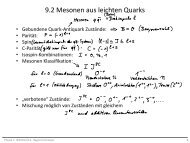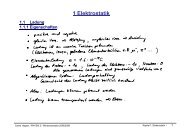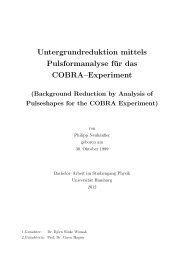Setup of a Drift Tube Muon Tracker and Calibration of Muon ...
Setup of a Drift Tube Muon Tracker and Calibration of Muon ...
Setup of a Drift Tube Muon Tracker and Calibration of Muon ...
You also want an ePaper? Increase the reach of your titles
YUMPU automatically turns print PDFs into web optimized ePapers that Google loves.
Counts/(10 keV × day × 100 tons)10110 -110 -210 -3All solar neutrinos7Be neutrinos0.2 0.4 0.6 0.8 1 1.2 1.4 1.6 1.8 2Energy [MeV]Figure 4.1: Expected spectrum <strong>of</strong> solar neutrinos in Borexino. Clearly the Comptonlikeedge from the 7 Be neutrinos can be seen at approximately 665keV. Figure from [67].leaves a recoil electron which deposits its energy in the scintillator. The resultinglight output is observed by photo multipliers. The energy transfer from the neutrinoto the electron is similar to that <strong>of</strong> a photon in a Compton scattering process. Thus,monochromatic neutrinos like the 7 Be neutrinos from the Sun (cf. Section 2.3)leave a characteristic shoulder in the energy spectrum. The expected spectrum forsolar neutrinos is depicted in Fig. 4.1. Monoenergetic 0.862 MeV 7 Be neutrinos fromthe Sun are expected to show a Compton-like edge in the recoil electron’s energyspectrum at 665 keV. As the reaction has no energy threshold, it is particularlywell suited for the detection <strong>of</strong> low energetic neutrinos. The scattering processis sensitive to all neutrino types ν e , ν µ , <strong>and</strong> ν τ , however, due to the possibility<strong>of</strong> both a CC <strong>and</strong> NC reaction, the cross section for electron type neutrinos isapproximately six times higher than for other neutrinos which can only interactwith ordinary matter by the exchange <strong>of</strong> a Z boson. Fig. 4.2 shows the Feynm<strong>and</strong>iagrams <strong>of</strong> the neutrino scattering processes on electrons in the scintillator. Asalready mentioned above, the energy transfer from the neutrino to the electron isCompton like. Scattered electrons then lose their energy to the scintillator throughexcitation <strong>of</strong> its molecules. Under emission <strong>of</strong> photons, these molecules then deexciteagain within a few nanoseconds. The photons’ energy typically lies nearthe ultra violet region. A wavelength shifter is added in small amounts to thescintillator. It absorbs photons from the initial scintillation process but re-emitsat a longer wavelength. This assures the scintillation light to travel through thedetector without being re-absorbed.The number <strong>of</strong> produced photons depends on the energy deposited in the scintillator.Organic scintillators typically produce approximately 10 4 photons per 1MeV<strong>of</strong> deposited energy. Hence, the number <strong>of</strong> photo electrons (p.e.) detected by thePMTs gives a measure <strong>of</strong> the energy deposited in the scintillator. The number <strong>of</strong>p.e. can be calibrated to the according energy using radioactive sources <strong>of</strong> known energy.Once the detector is calibrated, a spectroscopic measurement <strong>of</strong> the scattered52





